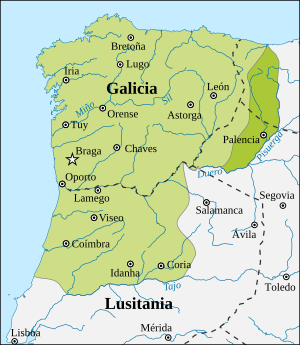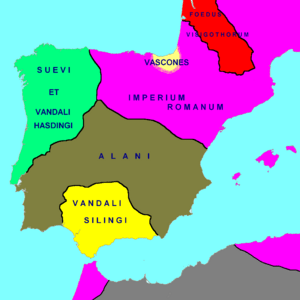Battle of the Nervasos Mountains facts for kids
Quick facts for kids Battle of the Nervasos Mountains |
|||||||
|---|---|---|---|---|---|---|---|
| Part of the Germanic Wars | |||||||
 The Suebi Kingdom under its maximum extension, 6th century. |
|||||||
|
|||||||
| Belligerents | |||||||
Kingdom of the Suebi |
Vandals Alans |
||||||
| Commanders and leaders | |||||||
| Gunderic | |||||||
The Battle of the Nervasos Mountains happened in the year 419. It was a fight between two groups of people. One side was a team of Suebi (led by King Hermeric) and their allies, the Roman Imperial forces. The other side was a combined army of Vandals and Alans, led by their King Gunderic.
This battle took place during a time when Germanic tribes were invading the Iberian Peninsula (modern-day Spain and Portugal). The fight happened in what is now the Province of León, Spain. The Roman and Suebi forces won the battle.
Contents
Why the Battle Happened
Germanic Tribes Move into Iberia
Between 409 and 411, several groups of people moved into the Iberian Peninsula. These included the Vandals and Suebi, who were Germanic tribes. The Alans, who were an Iranian people, also moved in. They came through the Pyrenees Mountains. Before this, they had already taken over the Roman province of Gaul (modern France). They spent three years there, taking goods and causing damage.
The Western Roman Empire was having trouble. They could not fight these new threats well. This was because of local uprisings led by Maximus of Hispania and Gerontius. The Germanic tribes saw this as a chance to invade the peninsula. They wanted to claim land for themselves. This started the period known as the Germanic Invasion of Iberia.
Dividing the Land
The invaders divided the lands of Hispania (the Roman name for the Iberian Peninsula). They took all of Hispania Tarraconensis from the Romans easily. The Silingi Vandals took control of Hispania Baetica. The Alans took over Lusitania and Hispania Carthaginensis. The Suebi and the Hasdingi Vandals took over Gallaecia.
The Suebi kept the Roman way of organizing land. They had their capital in Lucus Augusti (Lugo). They also had a center in Bracara Augusta (Braga). The Hasdingi Vandals also kept the Roman structure. Their capital was Asturica Augusta (Astorga).
Roman Allies and New Conflicts
In 416, Wallia, the King of the Visigothic Kingdom, came to the Iberian Peninsula. He was acting as a Roman general. His job was to fight the invading tribes. The Germanic tribes could not unite against him. By 418, most of the Silingi Vandals were defeated. The Alans were scattered after their king, Attaces, died in battle. The survivors of these groups joined the Hasdingi Vandals. After this, the Vandal kings were called "King of the Vandals and the Alans."
The King of the Suebi, Hermeric, made a treaty with the Emperor Honorius. This treaty gave his tribe the legal status of Foederati. This meant they were allies who received land from the Romans. The Hispano-Romans had to give up some of their land to the Suebi. This caused bad feelings that would lead to future conflicts.
Hermeric wanted his kingdom to grow. Because of his alliance with the Romans, he started to fight with his Vandal neighbors. The Vandals were the closest other Germanic tribe in Hispania.
The Battle of Nervasos Mountains
The exact details of this battle are not fully clear. It seems the Suebi started the fight. The Nervasos Mountains might have been in the region of El Bierzo. This area is now in the Province of Leon. At that time, it belonged to the Hasdingi Vandals under Gunderic.
During their invasion of Vandal lands, Hermeric and his army were surrounded. They were trapped in the Nervasos Mountains by Gunderic's forces. They were saved from a terrible defeat only by the timely arrival of Roman help. The Roman commander, Asterius, came with a strong Roman army. He broke the Suebi siege and forced the Vandals to leave.
The Roman campaign continued. Asterius made the Vandals retreat south to Bracara Augusta. There, he had planned a trap with his assistant, Maurocellus. Maurocellus commanded another large Roman force. They caught the Hasdingi Vandals and defeated them.
What Happened After
Vandal Movements and New Leaders
After their defeat, King Gunderic led his tribe to find new land in Hispania Baetica. Between 421 and 422, they defeated a Roman army. This army was led by General Castinus. He had been sent to take back former Roman lands in that area. The Vandals then built a large fleet of ships. They used these ships to control the sea in the region. They were able to conquer a large part of southeastern Spain. They attacked cities like Carthago Nova and Hispalis.
In 428, Gunderic died. His half-brother Genseric became the new king. Genseric decided that the best place for his people to settle was North Africa. This area was having many internal problems, which would make Roman resistance weak. Genseric began to prepare to cross the Straits of Gibraltar. He had over 80,000 people, including 15,000 warriors.
Suebi Defeat and Vandal Expansion
However, Genseric was attacked from behind. A large force of Suebi came under the command of Heremigarius. This Suebi army had managed to take Lusitania. This Suebi army was defeated near Mérida. Their leader, Heremigarius, drowned in the Guadiana River while trying to escape.
The next year, the Vandals landed in Ceuta. In just a few years, they would control all of Roman North Africa. Later, they would be conquered by Belisarius, a general of Justinian I.
The Suebi remained in Gallaecia until they were conquered by the Visigoths under Liuvigild in 585.
See also
 In Spanish: Batalla de los montes Nervasos para niños
In Spanish: Batalla de los montes Nervasos para niños
- List of Roman battles
- Decline of the Western Roman Empire


